CHIPPED NAIL POLISH
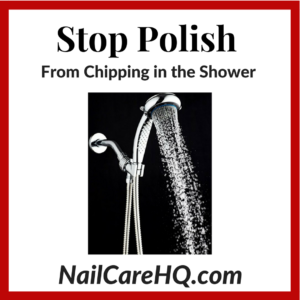 Chipped Nail Polish From The Shower
Chipped Nail Polish From The Shower
Are you tired of getting chipped nail polish when you take a shower? I certainly am!
By the end of this article, you’ll understand how I figured out why I kept getting chipped nail polish—and you’ll discover the solution.
Two years ago, after writing and publishing my book, What You Don’t Fix …Your Kids Inherit, I was tired. It had been a two year labor of love and I needed a break.
I was drained and only had one question on my mind – “How do I stop getting chipped polish when I shower?”
What I didn’t realize was my simple little question to eliminate chipped nail polish would lead me into a 14 day, 6 hour a day obsession. I had discovered the vast online world of nail polish and nail art bloggers.
The Journey
I started asking the Almighty Internet 8-Ball (Google) all sorts of nail related questions. Google eagerly dished up the answers. One page would lead me to another. One video would lead to another, etc.
Sadly, I found a lot of crap—completely wrong advice, old wives tales, bloggers who can’t spell worth beans, and horrendous videos that were blurry, boring and too long. You can totally relate, right?
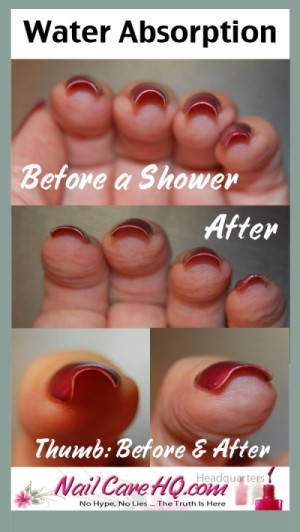
Where’s The Answer?
While weeding through everything, I also found tons of great information—little pearls of wisdom and other gems hidden in the thousands of pages I waded through. But still, no one had answered my question, “How do I stop getting chipped nail polish when I take a shower?”
Then, I discovered the first college textbook that I would willing buy and read without being enrolled in college! Nail Structure and Product Chemistry by Doug Schoon.
As I learned about nail structure and how the nails absorb water, my lightbulb turned on!
The Reason
Nails absorb water from both sides—through the pink nail bed and from the nail plate surface. All exposed areas of the nail plate absorb water.
As I wrote in my article about preventing peeling nails, healthy nails are a perfect blend of 18% water and 5% oil.
Bare nails can hold almost one-third of their own weight in water. Water molecules are so small that they easily pass through and around the 50ish layers of keratin cells.
Nail polish is a coating over the top of the nail. Although it looks solid, it is not. Water and oil can penetrate through polish, but at a significantly slower rate than when nails are bare. Many people wonder if oil can penetrate the polish to help their nails be stronger. The absorption is too slow to have any effect.
Nail polish also protects the nail plate from losing water and oil through evaporation and extensive hand washing, especially when using soap.
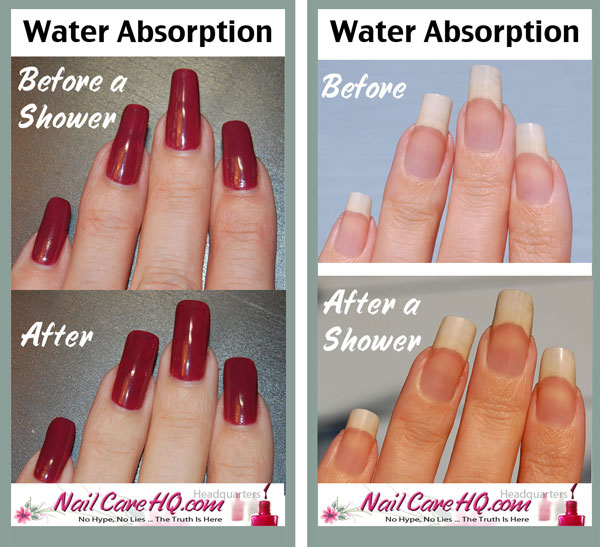
But… !!!
Like most of you, I use base coat and topcoat. I cap my free edges with polish and topcoat. Now the top of my nails are protected. But… the underside of my nails were bare—unsealed.
What Happens In Water
We all have a natural curve to our nails. Once nail polish has dried, it has dried to the same curve. But in water, bare nails soak up water like a sponge causing the nail’s curve to flatten out. Although polish has plasticizers to keep it flexible, the polish is forced into a flatter shape. That alone might be ok, but there is another problem.
Water Travels Through the Nail
In a 10 or 15 minute shower, excess water travels through the bottom to the top of the nail plate. The water breaks the bond with the polish—especially around the edges—which have received wear and tear from daily life.
Broken Bonds
With the combination of hardened polish bending and excess water traveling through the nail plate, the bond is broken between the polish and the nail plate surface. The result? Chipped nail polish!
Anna at LoodieLoodieLoodie has a great example of this in her crab feast blog post. Her nails were saturated from 2 hours of cracking open crabs.
She thought her manicure would survive but look what happened to the right! Her entire coat of polish just slid off in one sheet. Water absorption had completely broken the polish to nail bond.
The Solution
In order to help prevent chipped nail polish in the shower, prepare your nail plate properly before polishing for ideal adhesion, then completely wrap your nails in base coat and topcoat to slow down water absorption.
How to Prevent Chipped Nail Polish
Use the following tips to help you prevent chipped nail polish:
* Color nail polish is formulated to bond with base coat—not nails.
5. Using acetone and a makeup or artist brush, clean up your polish along the cuticle line.
* Here’s the article I wrote explaining why acetone is the best choice for removing polish.
6. Rehydrate your cuticle lines and surrounding skin with a high quality, jojoba wax ester based nail and cuticle oil
7. Apply a new layer of top coat daily or every-other day, wrapping it around your tips. Apply nail oil two or more times per day. More applications may be necessary during summer and winter.
TIP: The ingredients that make a good top coat bond to nail polish and have an incredible shine make it a horrible base coat! Steer away from any product labeled as base coat AND topcoat. It will do neither one well.
Removal
After 7 days, remove your polish with acetone. Acetone is actually less drying to your nails than non-acetone because it dissolves the polish quicker.
Soak and Swipe™
I like to unroll a cotton ball and cut it into small pieces about the size of my nails. Thoroughly soak the cotton piece with acetone and apply to pinky nail. Repeat with the other nails.
By the time you have finished to your thumb, soak another piece of cotton. With firm pressure, swipe the polish off—no need for scrubbing! Trust me, this will change your life!
* Use Q-Tip brand cotton swabs to remove the polish on the underside of your nails. I’ve tried cheaper brands and they’re just not as effective, perhaps because they’ve wound the cotton around the stick tighter than Q-Tip does.
In Conclusion
A full wrap of base coat and topcoat completely encases your nails in polish. Water absorption is minimized when you shower and wash your hands. This is the best way I’ve found to prevent chipped nail polish.
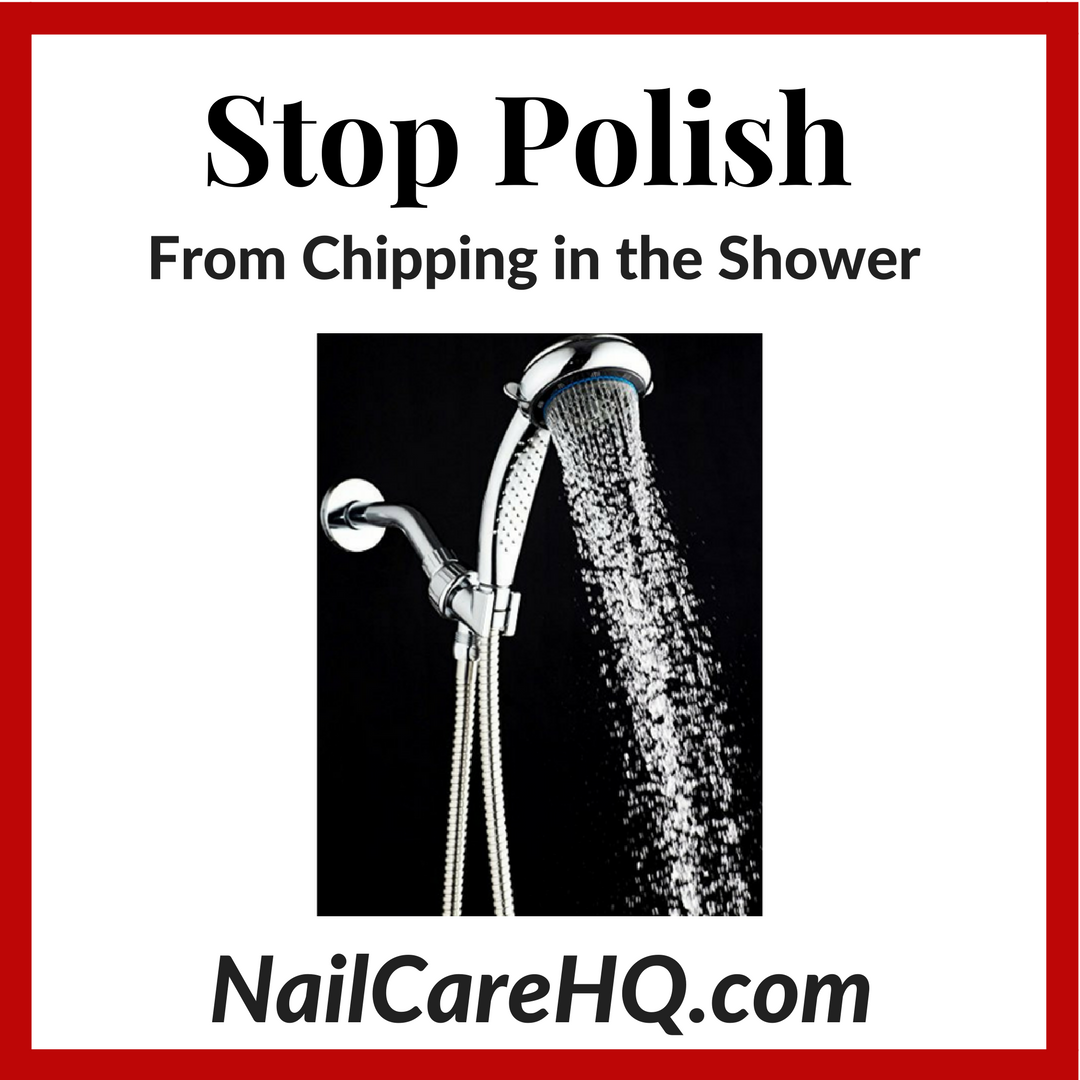
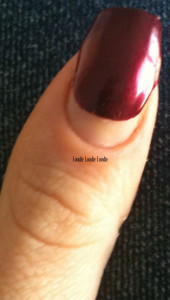
Excellent info…thanks!
You’re most welcome LaTanya! ~Ana
You’re very welcome Sherri! Yes, your biggest issue is water absorption.
Please stop washing your hands before polishing. I explain why in this article I just finished: https://www.nailcarehq.com/oil-causing-nail-polish-bubbles This is also another big contributor to the full nail peel of polish.
The techniques in that article also talk about all the ways to properly prep your nails for the best adhesion. Huggs! ~Ana
I love all the information …is soo good thank you.
You are most welcome Karen!
Great info – but what about short nails? mine are too short to get any top coat under there..?
Angela, then you will just want to make sure you cap your edges. Swipe the brush along the exposed free edge. This makes it harder for water to cause your polish to peel at the tips.
Realize that once you have worn that polish off with daily wear and tear, then the polish could peel. This is why it’s a good idea to reapply fresh topcoat every few days.
Thank you so much for these great nail tips!!! I didn’t know half of this stuff!!!! I am so glad that I found your nail blog/facebook page!!!!
Thank you so much for these great nail tips!!! I didn’t know half of this stuff!!!! I am so glad that I found your nail blog/facebook page!!!! and BTW I LOVE the design!!!! Beautiful!
Finally, a I asked Google a nail care question and received a scientific answer! Thank you:)
You are most welcome Krystin! That’s why I write. There’s too much horribly inaccurate info out there. ~Ana
Hello,
I read your article & I have to say it makes so much sense. I face the same problem, polish chipping away while I take shower. Normally, I get free time in the night to do my manicure, so at night I paint my nails. They look so pretty at night & next day when I shower, all my hard work is gone in drain(literally)!!
But, I realize my polish stays much longer when I don’t apply base & top coats to my nails while polishing them compare to when I do apply both base& top coats . Anna, can you please tell me why is it so? cause I feel without the base coat I am kind of risking my nails to discoloration & all other kinds of problems. Any thoughts on this, are most welcome.
Thank You.
Prajaka,
Hummm, your polish should not be staying longer without base at top coats. Color formulas are made to bond to basecoat, not nail plates. What may be happening is since you’re getting free time to polish in the evening, you may not be allowing the polish layers to thoroughly dry before applying the next coat. So if you’ve done one or two coats of basecoat, 2 coats of color and one topcoat, it many need more time to dry. If I don’t have a lot of time, I’ll do 2 basecoats one evening and then polish the next evening.
Also make sure that you wipe your nails clean with rubbing alcohol and a lint free pad to remove dirt and oils before applying basecoat.
If you follow the directions to my Fab 5 Polish Wrap, you should get longer wear from your polish. Keep applying a high quality jojoba based nail oil regularly several times per day. It penetrates the top layers of the polish to minimize cracking. Hope that helps! ~Ana
do you have a video showing how to completly wrap the nail with base/top coat? aslo what colors are you using in your video above here 🙂
Christina,
I don’t have a video yet, but I’m working on one now. I couldn’t tell you what polish color I used for this article…it was over 2 years ago and I have over 700 polishes. ~Ana
That was amazing, I love it when I come across a well researched answer to a question that’s been bugging me forever. Thank you!
You’re very welcome!!!! ~Ana
This is crazy good
How come your nail bed isn’t the least bit red or irritated when your nails are so long? Don’t they ever catch onto something aka turn upwards (yeah sounds painful i know lol) when doing random stuff?
My nails are so flexible they turn every which way, which is annoying as hell. Went even to see a dermatologist to make sure i didn’t have a fungus or something causing the line of redness on my nail bed.
He told me it was the lever action from the nails being long and getting caught onto stuff.
I also have the issue with the shower lol. I had it happen that over half (!) of my polished nails, the polish just slid off in one piece. What do you do though if you have short nails and can’t really go underneath the nail with the base and topcoat?
Dieamond, since I have such a strong c-curve, my nails do not bend upward. This usually happens to people with very flat nails. My nails will bend downward when they meet a hard external force. I have to be extremely careful when changing the sheets on my bed…or I get my husband to do it 🙂
Make sure you follow the polishing directions at http://www.NailcareHq.com/fab-5-polish-wrap-polish-chipping/ If your nails are short, just cap the tips with polish. Keep oiling your nails daily and you should get longer wear. ~Ana
I’ve been trying to tell my friends this for literally YEARS, yet no one believes me. You’re doing a God’s work lol
Hello Ana,
I have found a way to keep my nails dry while showering and washing my hair! Here goes
Wear thin vinyl or nitrile gloves (no latex, no powder)- gloves available in the cleaning supplies section of supermarket
Wrap a rubberband or place a hair elastic around wrists ( if wrists are small, go with rubberbands)
Shower quickly
Dry gloves as you would your hands and remove elastics
Turn bottom of gloves up for drying. I get about 2 weeks from a pair before they develop pinholes.
This helped me through the 3 day challenge, and now I do it routinely. No circulation problems.
Thanks for the great oil and all the valuable information.
Annette
Annette, thanks for your tip! It will help so many others.
Wow!!!!! I always feel sheepish when I ask the gal at the salon to cap the free edge but do it anyway, and half the time she forgets and only caps half….Meanwhile…..the top and base should be more than capped! And I’m going to stop cutting the cuticles……so much helpful and biology-based info…thank you so much!!!!! My mani maintainer (me( thanks you…..will be doing more of them at home….Heavens knows I have enough polish!!!!
Hallelujah!!!!!! ? FINALLY. I can’t wait to try this out. I dread ruining my polished nails in the shower! Great article!!
heyy great article!! Good job .
Thank you for this very tec and interesting info. I’m a pensioner and had to work hard for a living so not enough time to spend on nails I realise now the damage I have done and am spending more time on myself. After losing 3 stone revamping myself I went to have a manicure. It has made my nails worse than they were before but I realise now I loved them they looked beautiful and made me feel so good I need more but cannot afford. So am reading all I can to do it myself. I really appreciate your article and will be following you from now on. Once again thank you.